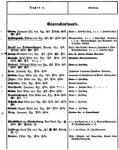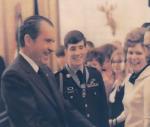-
Posts
4,908 -
Joined
-
Last visited
-
Days Won
97
Content Type
Profiles
Forums
Blogs
Gallery
Events
Store
Everything posted by Dave Danner
-
Here is a grainy photo with the 12 ribbons I referred to. It looks like the first seven are his American awards - the DSM, the five campaign medals and the Victory Medal with its stars. Then comes on row three the Criox de Guerre with Palm, followed by the Order of Leopold I with its rosette and band. Row four appears to be the plain ribbon of the KCB, followed by the ribbon with rosette and band of the Commander of the Legion of Honor, and then the Order of the Crown of Italy. So the Panamanian Medalla de la Solidaridad is not worn.
-
US: Distinguished Service Medal, Army Indian Wars Medal, Army Spanish Campaign Medal, Army Army of Cuban Occupation Medal, Army Philippine Campaign Medal, Army (Philippine Insurrection) China Campaign Medal, Army (China Relief Expedition) World War I Victory Medal (bars should be Aisne, Aisne-Marne, Champagne-Marne, Defensive Sector, Meuse-Argonne, St. Mihiel) Foreign: Croix de Guerre with Palm, France Grand Officer of the Order of Leopold I, Belgium Knight Commander of the Order of the Bath, Great Britain Commander of the Legion of Honor, France Grand Officer of the Order of the Crown, Italy Medal of La Solidaridad, Panama In post-World War I photos, he is shown with 12 ribbons, so at least one of these wasn't worn. Your ribbon ID is not right. The first ribbon should be the Indian Campaign Medal, which was an all-red ribbon until being changed in December 1917 to add two black stripes. #2 is the Spanish Campaign Medal, whose blue and yellow stripes blend together due to the color shifting (if you look closely, there is a slight color difference toward the center. #3 should be the Philippine Campaign Medal - again, the blue of the wide center stripe and the narrow edge stripes is color-shifted to be lighter than the red stripes. #4 is probably the Army of Cuban Occupation Medal, whose blue center and edge stripes are color-shifted in the B&W photo. #5 is likely then the China Campaign Medal, with the blue and yellow stripes blended together.
-
Bernhard von Hartz was born in Munich, as were both of his children. Karl Freiherr von Nagel zu Aichberg was born in Amberg. He married an American woman in Munich. His surviving daughters married non-Germans and ended up moving to, and dying in, the USA. Gustav Scanzoni von Lichtenfels was born in Würzburg. His son Albert was also born in Würzburg, but resided in Munich. I don't think Albert had any children.
-
Hippe is in the 1919 Dienstalterliste as a Hptm. des Ingenieur und Pionierkorps, and in the Ehrenrangliste as a Maj.a.D. He was still on active duty on 27 May 1920, when he was a Hptm. in Techn. Abt. 1, and was commanded to the Inspektion für Waffen und Gerät. However, I do not see him there in the 1 October 1920 Stellenbesetzung für das Reichsheer.
-
Hermann Freiherr von Stein - 11.2.1859-26.2.1928 - General der Artillerie on 28.5.18 Philipp von Hellingrath - 22.2.1862-13.12.1939 - General der Kavallerie on 28.5.18 Konrad Krafft von Dellmensingen - 24.11.1862-21.2.1953 - General der Infanterie on 8.8.18 (ernannt) Bernhard von Hartz - 12.4.1862-xx.xx.1944 Paul Ritter von Kneußl - 27.6.1862-16.2.1928 - char. General der Infanterie on 18.8.19 Nikolaus Ritter von Endres - 25.10.1862-23.9.1938 Friedrich Hurt - 20.3.1859-4.10.1941 Hugo Ritter von Huller - 26.11.1859-12.7.1931 Otto Ritter von Jäger - 18.3.1861-26.7.1941 Otto Schlosser - 31.8.1862-??? Hermann Ritter von Burkhardt - 26.8.1861-9.9.1942 Karl Ritter von Riedl - 9.6.1862-20.11.1919 Otto Ritter von Rauchenberger - 11.09.1864-7.8.1942 Karl Ritter von Schoch - 5.8.1863-10.10.1940 Eugen Ritter von Clauß - 25.10.1862-23.2.1942 Hermann Beeg - 24.11.1861-30.12.1932 Karl Graf Wolffskeel von Reichenberg - 18.4.1847-13.3.1919 Hans Freiherr von Laßberg - 18.1.1854-18.2.1952 Oskar Reuter - 3.1.1862-??? I'm not sure why some are crossed out. In some cases, they died, but the dates of death were much later. But several others whose names aren't crossed out were also dead by the same point as some whose names are.
-

Oberstleutnant Hauß
Dave Danner replied to dedehansen's topic in Deutsche Kaiserreich: Man spricht Denglish
Hauß war Darmstädter. In 1915 war er Btl.Fhr., I./LIR 23. Meine Einschätzung der Feldspange: 1. EK2 2. HOH3X 3. vermutlich HT 4. vielleicht OFAK2 mit der Spange "Vor dem Feinde" 5. vielleicht HH 6. RAO4 7. DA 8. Centenar. 9. ÖM3K -
The 1913 Prussian Court and State Handbook shows Christian Blunck with the following: RAO4, KO3, GV4, OV3a, RA2, SN3. In 1913, he received the RAO3mSchl and the MU3 (Montenegrin Order of Danilo). In 1915 he received the pinback SA3. He retired from Prussian state service in 1916 and received the KO2. So probably not him, unfortunately.
-
#3 is the Württemberg Friedrichs-Orden, Knight 1st Class with Swords (WF3aX). For #4, the Zähringen Lion is a Knight 2nd Class (BZ3bXE) I would guess that #5 and #6 are the Hesse Tapferkeitsmedaille and the Hamburg Hanseatenkreuz. #11 is probably Bulgarian - the Military Order "For Bravery" or the National Order "For Military Merit" on the bravery ribbon.
-
This would be really subjective. Even the rankings are suspect: both the Americans in the source KIR cites and the British in Histories of 251 Divisions of German Armies evaluate units at particular points in time. A unit which fought well for almost the entire war until it was battered down, which then went to the Argonne Forest in 1918, might be treated by the Americans as lower quality, despite its long-term record. But just to play the game, I would add GR 110 to the list. Of Baden regiments, it had the most knights of the Military Karl Friedrich Merit Order and recipients of the Military Karl Friedrich Merit Medal. Still, LGR 109 was a close second with one more knight and three fewer medals. Three GR 110 MKFVO knights also had the Pour le Mérite, but I'm not sure of the total.number of plMs for the regiment.
-
In the 1914 and 1918 Ranglisten der Kaiserlich Deutschen Reichsmarine and in the Ehrenrangliste der Deutschen Marine, we find a Marineinfanterie officer, Maj. Schneider, who led the Skutari Detachment and was later a battalion commander in the 3.MIR and then regimental commander of the 2.MIR. He received the Knight's Cross of the House Order of Hohenzollern with Swords and the Oldenburg Friedrich August Cross 1st and 2nd Classes, among other decorations. He also had a peacetime RAO4 and an Order of the Zähringen Lion, Knight 2nd Class with Oakleaves. He entered the Army on 22.3.1888 and the Marineinfanterie on 1.10.1908. His Dienstalter as Major was 1.10.13 K12k. According to these sources, his name was Paul Schneider and he was born on 31.5.1869. The 1914 Vollständige Dienstaltersliste shows the following for Maj. Schneider of the Marineinfanterie: - 21.9.89 Lt. [sek.Lt.] - 22.3.97 OLt. [PremLt.] - 15.9.04 Hptm. - 1.10.13 Maj. According to various rank lists and the Militär-Wochenblatt, the officer with these promotions had the following career: commissioned as a Sek.Lt. in IR 129, transferred to IR 142 on 17.5.1892, discharged from the Army on 30.9.1908 and appointed into the Marineinfanterie on 1.10.1908. Here's the mystery: according to the Stamm- und Ranglisten sämtlicher Offiziere des 3. Westpreuss. Infanterie-Regiments Nr. 129 von 1881 bis 1906, the Hptm. Schneider with this career path, down to every detail up to 1906, was not named Paul, but was named Arnold Friedrich Hermann, and was born on 27.3.1865 in Carthaus bei Danzig. Any ideas which might be correct? The IR 129 Stammliste is very detailed, but I suspect it might be wrong. It has him leaving the Hauptkadettenanstalt on 22.3.1888 (which fits the Army entry date in the Navy lists), but if he were born in 1865, 23 is awfully old to be graduating from the HKA. 1869 is a far more likely birth year for such a person. I don't have an IR 142 Stammliste, if one exists, so I can't check that. Here is the Stammliste entry: Here are the 1918 Navy and Ehrenrangliste entries:
-
The cipher "GFC" is for Schwarzburg-Sondershausen. Unfortunately, that is the only roll that is missing. There are rolls for all the swords awards, but for the Eichenbruch, only the Schwarzburg-Rudolstadt rolls are intact. I can make a guess, though. Although Schwarzburg-Sondershausen was smaller than Schwarzburg-Rudolstadt, and although the same man, Fürst Günther Victor, reigned over both principalities during the war, there were more awards from Sondershausen than from Rudolstadt. On average, there were about twice as many. For example, for the 2nd Class with Swords it was 58 to 23 (2.5 to 1), for the 3rd Class with Swords it was 674 to 369 (1.8 to 1), and for the 4th Class with Swords it was 87 to 33 (2.6.1). There were 40 awards of the 4th Class with the Eichenbruch from Rudolstadt. Based on the ratios above, I would say there were about 70 to 100 awards from Sondershausen of your award. So, while I can't say with certainty, I can say you have a rare and beautiful award. Best regards, Dave
-
Modern era ribbon bar. Missing ribbon after a Good Conduct and before an NDSM, with no indication of reserve component service. My best guess, an Army of Occupation Medal for service in the Berlin Brigade before 1990.
-
The Charakter was a "bump up" in rank which usually took place at retirement. Sometimes officers who had not been fully retired, but placed "zur Disposition" also later received "char." promotions. In Krause's case, the promotion to char. GMaD on 31.3.20 was a retirement promotion, while the promotion to char. GLaD on 27.8.39 was a Tannenberg promotion, given to veterans of the Battle of Tannenberg on the 25th anniversary. I think there are threads around discussing who got these Tannenberg promotions.
-
Revisiting this topic, what about Fähnriche and Fahnenjunker? For example: Eduard Bachelin, the later HOH3X and MKFVO recipient, born in Mannheim, Fähnrich in IR 113 on 18 October 1901, Leutnant on 18 August 1902. Adolf Davids, later HOH3X recipient, Fahnenjunker in IR 113 on 1 September 1901, Fähnrich on 22 April 1902, Leutnant on 27 January 1903. Rudolf Hoppe, Fahnenjunker in IR 113 on 26 October 1901, Fähnrich on 19 June 1902, Leutnant on 19 May 1903. Also, did you have to be in a Baden unit on 25 April 1902, or was there a timeframe around the date of the decree? For example, Edmund Freiherr von Villiez transferred from JB 10 to IR 113 on 18 July 1902. So was he too late? Thanks, Dave










